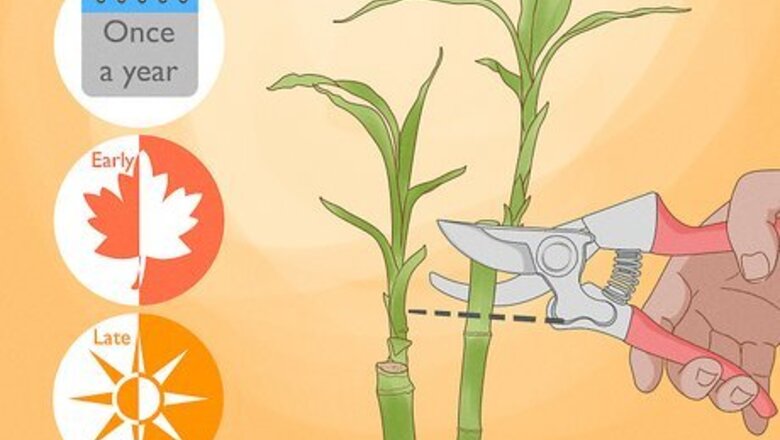
views
Mastering Pruning Basics

Prune once a year in late summer or early fall to minimize spreading. Although bamboo has a rapid growth rate, you only need to prune it once a year if you do a really thorough job. Pruning your bamboo more frequently can actually cause it to send off more shoots. Mark on your calendar when to start pruning and coordinate it with fertilizing.
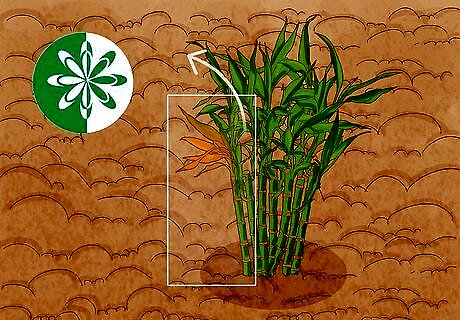
Cut down weak or dead canes in the spring to keep your plants healthy. Get a pair of sharp single-handed pruning clippers. Place them at the very base of each cane that appears diseased or damaged. Cut them out with a single horizontal slice.
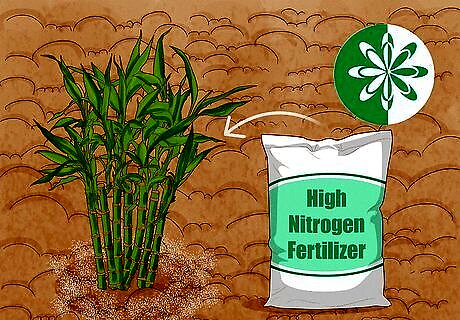
Fertilize your bamboo plants in the spring. A week before pruning, it’s a good idea to give your bamboo a boost. Apply a high nitrogen fertilizer to the soil surrounding your bamboo. Follow the application instructions to ensure that you dilute it properly, if needed.

Wear eye and hand protection. Branches and leaves can cut your skin in a bamboo grove, so it’s a good idea to wear sturdy gloves, long pants, and a long-sleeved shirt. Wearing sturdy gloves will also make it easier to handle and cut the canes.
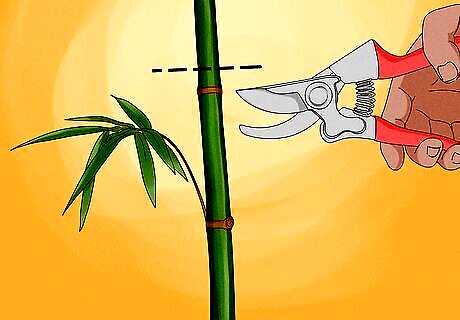
Cut above a node if you are trying to reduce height. Nodes are where the pieces of the stem join together. You’ll see a slight bump or bulge on the stem shaft indicating this joining. To trim down the height of a bamboo plant, locate a node. Then, position your shears or plant saw right above it and cut across. Making your cut above the node also makes the pruning process easier, as these spots are less thick.

Make straight cuts across the bamboo stem. Bamboo is very strong and if you cut it at an angle, it can be quite dangerous. Keep your cuts blunt and horizontal to minimize the risk. You should be able to use hand clippers for most cane. However, if the cane is rather large, opt for a pruning hand saw and extension.
Targeting Certain Parts of the Plant

Remove any dead leaves or sticks from the plant’s base. Feel around the base of each stalk of cane while wearing gloves. Gather up any loose plant waste or debris and place it in a trash can. Maintaining a clean base around your canes will lessen the chance of insect issues.
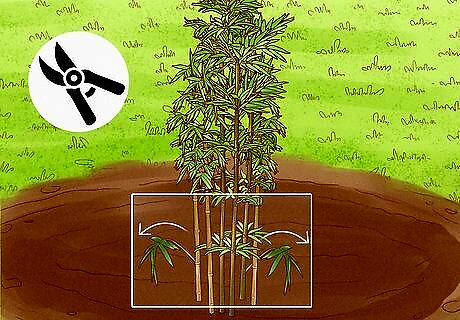
Snap away any low-lying branches. A cane field with a ton of low-hanging foliage can look sloppy and chaotic. Inspect each cane for these bottom branches, which are usually quite thin and undernourished. Grasp each of these branches near the stalk and simply snap them away with your hands. If the branch is too thick, cut it away with your secateurs. Just make the cut as close to the stalk as possible.
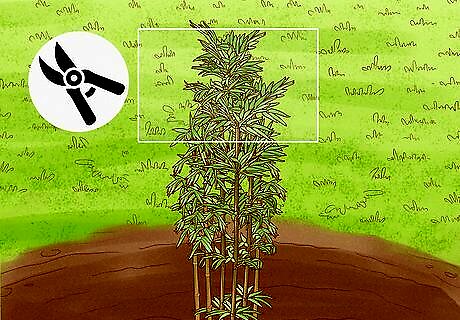
Take off any top-heavy leaf masses. If you notice that the very tops of your bamboo stalks are bending, then use a pole saw or trimmer with an extension to thin them out. Removing these overhanging stalks will improve airflow around your plants. It will also make your entire planting area look more attractive and cared for.
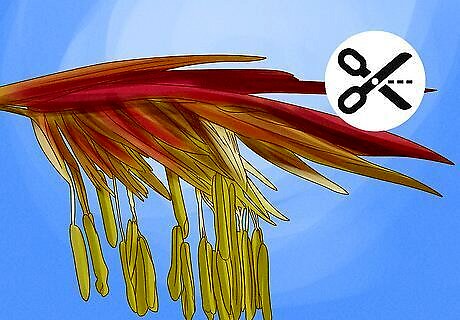
Trim away any flowering shoots. Flowers are often admired in most plants but can be a sign of stress for bamboo. If your bamboo begins to flower, cut off the flower and its attachments. If the flowering spreads all over the plant, it’s best to leave it alone, as too much pruning can be harmful. A bamboo’s flowers generally have a feather-like appearance. Another way that you can help a flowering bamboo is to make sure that the base of the plant is clear to allow good air circulation.
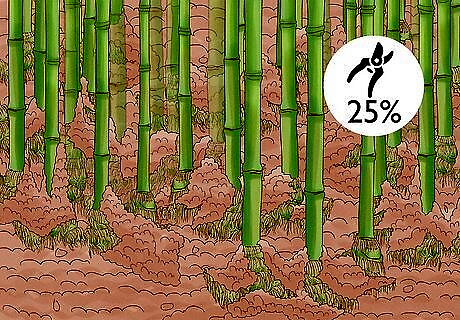
Thin out any thick root clumps. For established bamboo plants, look at the base and see if the roots appear above the soil. If they do, use your trowel to dig out and remove some of the roots. Remove 25% or less of the visible roots during a single pruning session or you’ll risk hurting the plant. But, pulling out some will help it to get water and air.
Containing the Spread of Bamboo

Pull out new shoots of clumping bamboos. Look over the open ground near your established bamboo plants. Clumping bamboos spread by extending new, small clumps of bamboo shoots that sit near the dirt surface. To prevent or control this, use a trowel and pull up these clumps. Unlike running bamboos, clumping plants are less likely to spread aggressively.
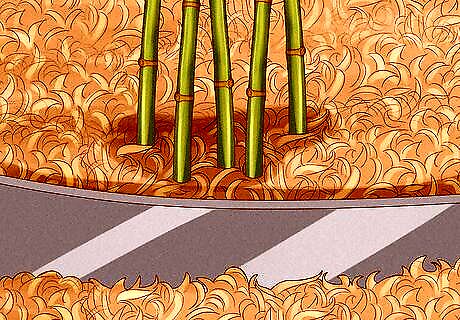
Install a plastic barrier for running bamboos. This type of bamboo is known for sending out both above- and below-ground shoots to aggressively expand. To slow down the spreading process, buy a thick plastic rhizome barrier from your local garden store. Dig a trench 22 to 30 inches (56 to 76 cm) deep surrounding the bamboo that you’d like to contain. Bury the barrier in this trench and re-cover it. This will help to prevent deep bamboo shoots from spreading underground.
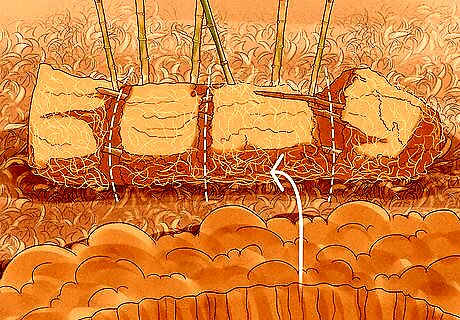
Dig out and break up the root system. This works best for young bamboo plants that are beyond being shoots but are not fully established. You’ll need to dig quite deep in order to access the full root ball. Then, use a shovel or spade to pull it up from the ground.

Dig a trench to stop the spread of bamboo shoots. Your trench will need to be 2 to 4 feet (0.61 to 1.22 m) deep to have any true effect. And, you’ll need to maintain it regularly, as it’s best to leave the trench continually empty. Filling your trench with concrete or rocks isn’t usually effective, as any cracks in these surfaces will allow for the transfer of shoots.

Know that chemicals aren’t usually effective at controlling the spread of bamboo. Even if the plant browns and the leaves fall off, it will likely send off fresh shoots in new directions. Instead of using chemicals, it’s best to concentrate on developing a regular pruning and containment routine.
















Comments
0 comment